What Is Realism in Art and When Did Each Take Place
A simple search for the definition of Realism or Realism art movement inevitably leads to one figure — French artist Gustave Courbet. His statement alleged in a pamphlet post-obit the rejection of his painting The Artist's Studio from Paris Universal Expo in 1855 can be taken both equally a definition and explanation of Realism. He only wanted to "know in order to do… To be able to represent the customs, the ideas, the appearance of my own era according to my own valuation; to be non only a painter but a human also; in brusque, to create living art".[1] This argument although ushered during the menses of Realism in France can discover its application fifty-fifty today when mod and contemporary forms of realist subjects are examined. In what follows a curt history of the evolution of Realism in visual arts and painting in particular will be outlined, with a focus on contextual changes that influenced the definition of Realism and Realism art movement through the ages.
Information technology is important to notation, however, that Realism is non an fine art movement pertinent solely to visual arts only to literature equally well. Realism every bit a literary genre relates to subject of homo condition and realist representation of people and their social life. In the 19th century realist writers such as William Dean Howells and Henry James used such themes in their piece of work.

The Definition of Realism and the Realisms before Information technology
Any enquiry in art and theory of realism should not avoid two important, if opposing voices that influenced general understanding and definition of fine art and realism in particular. Aristotle and Plato had awarded art different purposes—both related to free copying of forms artists encounter. For Aristotle painters re-create and perfect forms that are nowadays in nature in club to acquire and teach others nigh these objects, while for Plato painters copy forms from some abstract, ideal world.[two] Although both dealt with the real as a starting point, their agreement differs regarding the reality the artists aim to represent. Yet, the foundation for understanding art as mimêsis or a copy of reality was laid, and will influence many artistic and theoretical approaches in the futurity.[iii]
Realism in fine art has a long standing history. It tin can exist roughly divided into two subgroups both defined by the choice and treatment of subject thing rather than by the attention to visual appearance.[4] From early Upper Paleolithic representations of animals to Greek, belatedly Medieval and early Renaissance art realistic and naturalistic representations were marked past idealism, and representations of religious or historical themes. Ordinary or mundane subjects slowly emerged in fine art first in the form of Drolleries and more openly in fine art from 15th century onward.
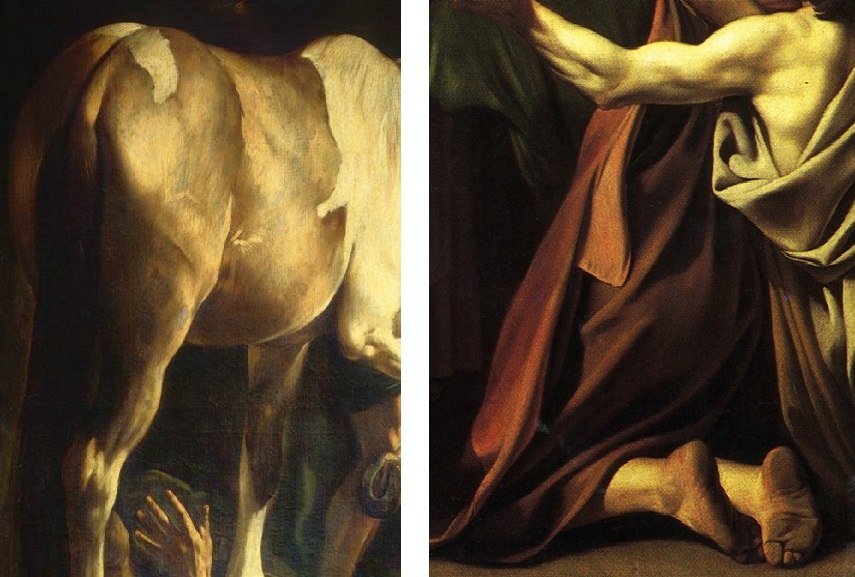
Carravaggio's Realistic Mysticism
Although religious imagery in Caravaggio'southward time sought to represent dogmatic truths and biblical events realistically, any resort to the everyday was rejected every bit inappropriate and offensive. Caravaggio's Madonna di Loreto, among other of his known works, broke decorum of the time by prominently showing two pilgrims and their dirty feet at the fore of the painting.[5] Beside naturalism, criticism was likewise directed towards the plain advent of the Madonna who could exist easily mistaken for any other woman. Caravaggio often used people from lower class such equally famous prostitutes as his models, which more than once lead to shock and rejection of his works by commissioners. Another example is Conversion of Saint Paul where horse's backside takes central stage, while Saint Paul is prostrated on the ground. Such and similar paintings oscillate between the naturalism of the everyday and required idealism of the religious events—or going back to Plato and Aristotle—between the mimêsis of objects painter sees in life and those that should have been seen and represented.
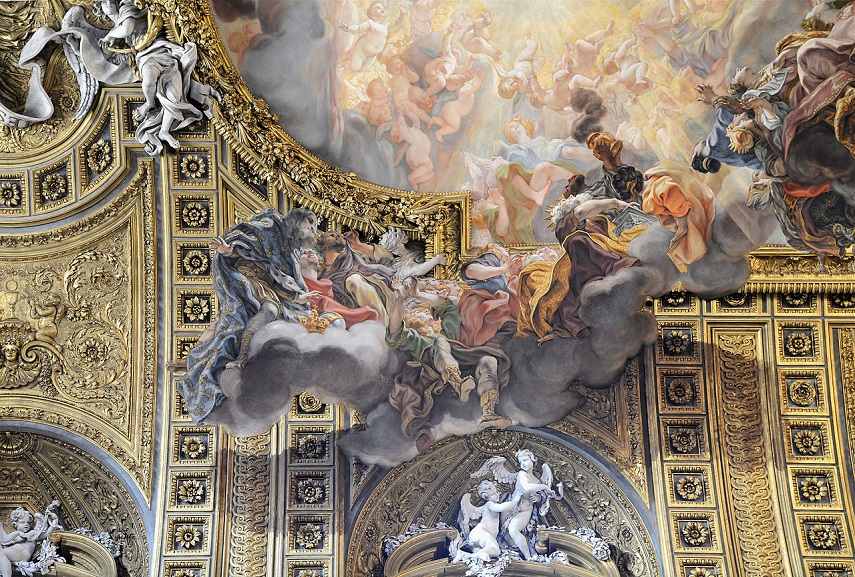
Trompe-l'oeil - The Illusion of Reality
Although many may link trompe-l'oeil mode of painting with realism, trompe-l'oeil really strives to imitate the existent, and the style came from the will of artists to fool the viewers into believing that what they meet is real. While realism strives to represent rather than imitate, trompe-fifty'oeil creates an illusion of free and open space through forced perspective often employed on walls and ceilings, equally well every bit in depictions of objects in three dimensions. The early on examples go back to artifact and preserved murals from Pompeii, while the best know examples of trompe- fifty'oeil were created on ceilings and walls of Baroque churches and palaces.
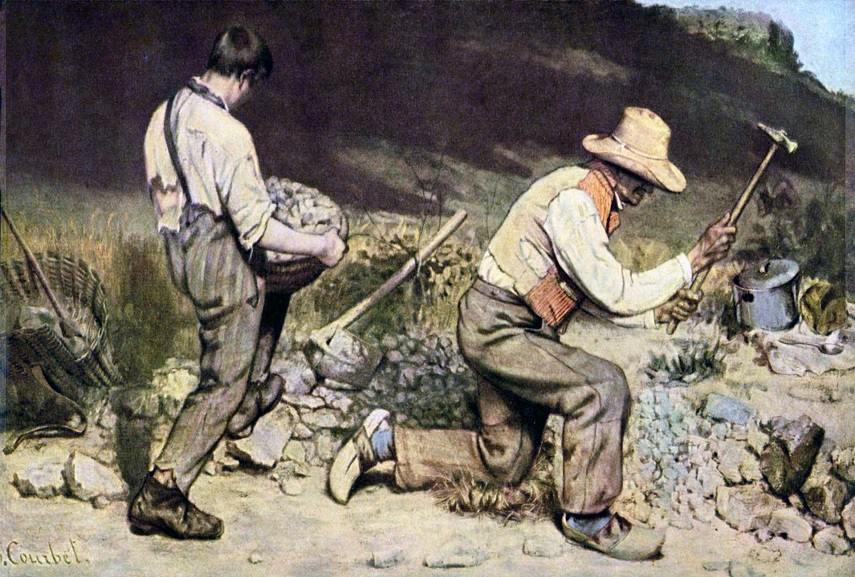
Realism and the Belief in Scientific Mind
Changes on the European scene upon which Realism (1840 - 1860/lxx) will appear started with the Industrial Revolution and the Revolutions of 1848 when feudal organisation was attacked and ideas of nation states developed. Revolutions in the 19th century brought secularization of societies and the new belief in scientific listen, as exposed in Positivist philosophy. World was there to be 'known' and observed, and artists took their office in this process. Gustave Courbet is regarded a pioneer of new style, but other artists before him too took a swell interest in what was there earlier their eyes, opposing Romanticism of the preceding years. Most notably Honoré Daumier and the French painters of the Barbizon Schoolhouse such equally Théodore Rousseau and Jean-François Millet created paintings where depictions of everyday subjects such equally work in the fields were present, but the general, almost pastoral temper of beautified and idealized reality rob them of the title of truthful Realists. Society that was emerging from Romanticism sought dazzler enclosed in the transitory and not in the eternal every bit Baudelaire would explain. Afterwards the abolishment of the bureaucracy of genres in academies, art ought to become, as French fine art critic Jules-Antoine Castagnary said: "…a piece of mirror in which generations behold themselves."[6]
Hailed as a flag-bearer for the whole move, Courbet'south painting The Stonebreakers from 1849 contains novel elements that would define Realism—ordinary subject field raised to a level of symbol of human struggle, realist depiction of modern course society, and most chiefly display of beauty and dignity of human toil.
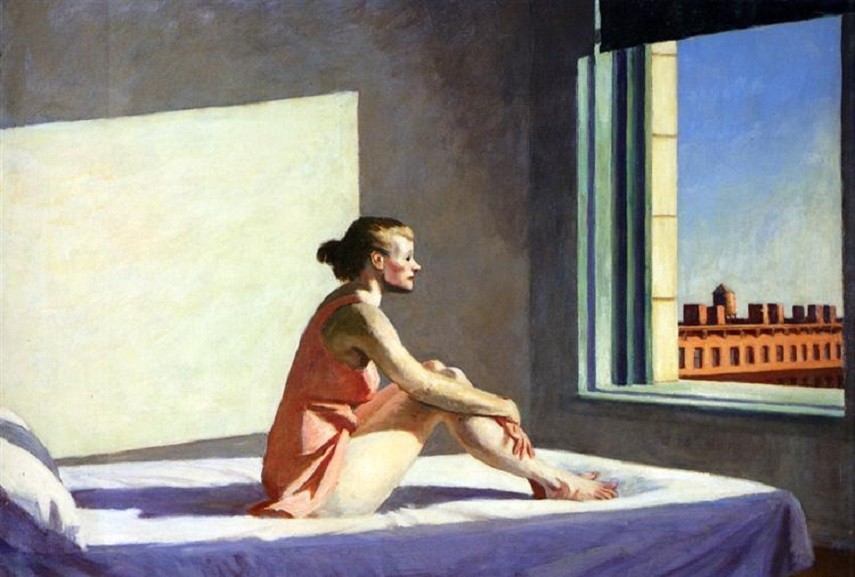
Ashcan school, Social Realism and Precisionism
Developed in the U.s.a. in the first half of the 20th century, these fine art movements had in common general interest in the surroundings and reality of modern life. Painters of Ashcan school (1908-1913) found inspiration in streetscapes and genre scenes. They chronicled life in New York, and although the school was of short duration, it had pregnant influence on American art scene. Among the well-known members of the school were John Sloan, George Luks and George Bellows. American Social Realism (1920s - 1930s) was straight influenced by Ashcan school. Artists belonging to Social Realism such as Ben Shahn, Edward Hopper, Jack Levine or Jacob Lawrence depicted social issues and hardships during the menstruation of Depression. Precisionists, Charles Sheeler, Charles Demuth and Georgia O'Keeffe worked in the same period with a slightly dissimilar aesthetic style. They employed the aesthetic principles of Cubism and Futurism in their depictions of industrial and urban landscapes for which they were likewise referred to as 'Cubist-realists' and their style as 'sharp-focus realism'.[7]
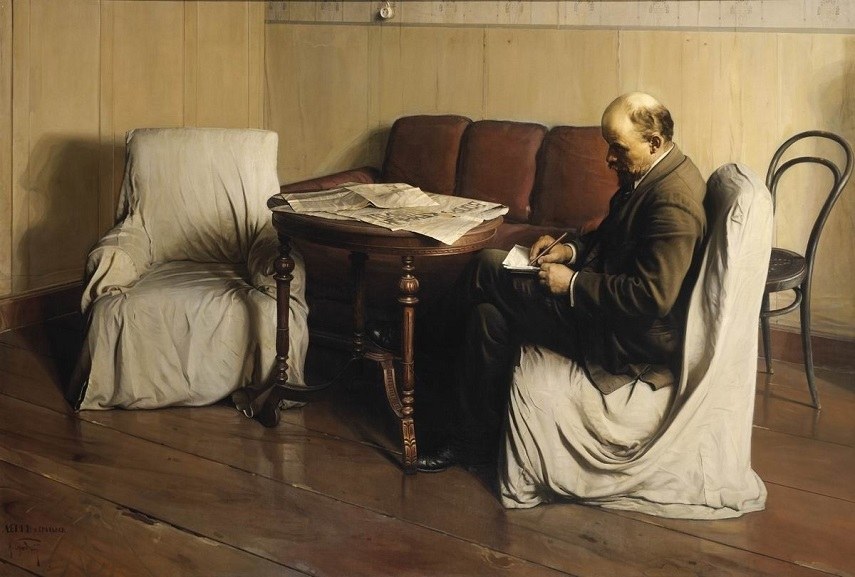
Socialist Realism Art Movement equally an Ideological Tool
Dramatic changes on the fine art scene that marker the end of the 19th and the beginning of the 20th century side-lined Realism to the back of the artistic interests, but after the World Wars Realism came back with a vengeance. Not only was Realism now again present, only information technology took the place of official fine art among the new Communist states of Eastern Europe. Unlike historical and Social Realism and their interest in workers' lives and struggles, Socialist Realism became institutionalized artistic practice with heavy ideological backing. Different themes came to preoccupy painters, who were guided by official politics in depicting scenes of satisfied workers and their leaders who are together building a ameliorate hereafter. Socialist Realism became the official art with clear guidelines of what can be represented—realist scenes that workers can easily empathize taken from everyday life and supportive of the country's aims.[8]

Realisms of Surrealism, Neue Sachlichkeit and Popular Fine art
With the evolution of photographic technique and increased presence and use of photography from the beginning of the 20th century onward artists tried to discover other styles and techniques that would continue to be relevant in a globe now hands represented through the photo camera. Everyday reality became non just redundant as a painterly theme and theme in literature, but artists soon realized that in social club to compete with photography they needed to turn to other realities too. The development of avant-gardes from the early 20th century and break with tradition saw the development of several artistic movements that intervened into what was understood as realism and brought to the foregrounded of their works the underbelly of the astounding earth. Congruent with the evolution of psychoanalysis, new involvement emerged in individual experience and individualized realities where naturalism relates to the realities of the unconscious.

Surrealism and the Unconscious Reality of Being
Surrealists in the likes of Paul Éluard, Max Ernst, Salvador Dalí, Human Ray, Hans Arp, Joan Miró, Marcel Duchamp, and Yves Tanguy turned to explore the unconscious reality, nightmares, fantasies and desires, frequently mixing everyday objects and familiar forms with phantasmagorical motifs. Developed from the Dada move in the 1920s Surrealism responded to the horrors of the World War One through depiction of reality that lurks behind the witting mind of each private.
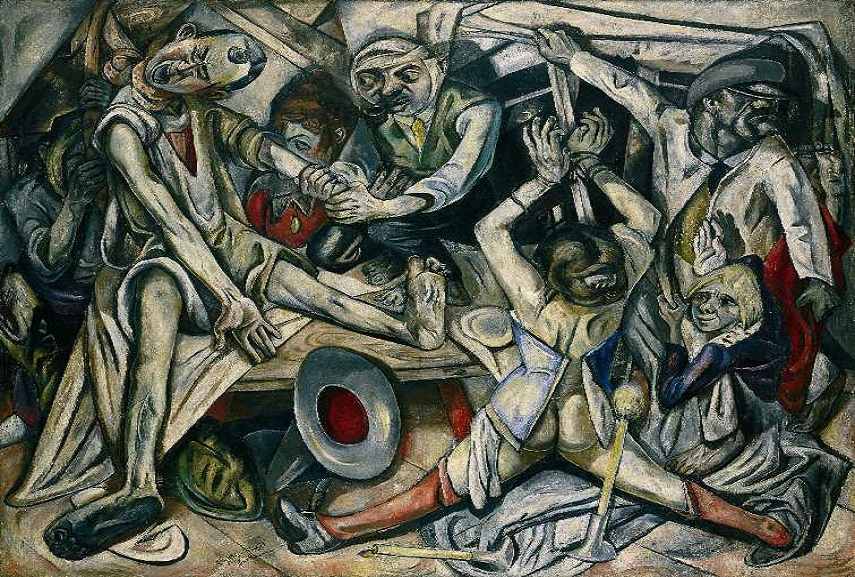
Neue Sachlichkeit of Postal service – State of war Reality
This art movement emerged effectually 1920s in Germany, and was direct influenced by Metaphysical painting of Giorgio de Chirico and other Italian painters. Return to reality following the war came equally a consequence of disillusionment; abstract fine art was no longer acceptable and different aesthetics was needed in club to criticize and correspond the horrid country of the mail service-war society and its leaders. Neue Sachlichkeit or New Objectivity emerged in two variations—the one preoccupied with objects and the other more critical and engaged with the everyday. Works of Otto Dix, Max Beckmann, and George Grosz are among the best examples of this movement. Non concerned with veracity of representation, the artists of Neue Sachlichkeit aimed to show listen sets and realities that lead to European disaster.[9]
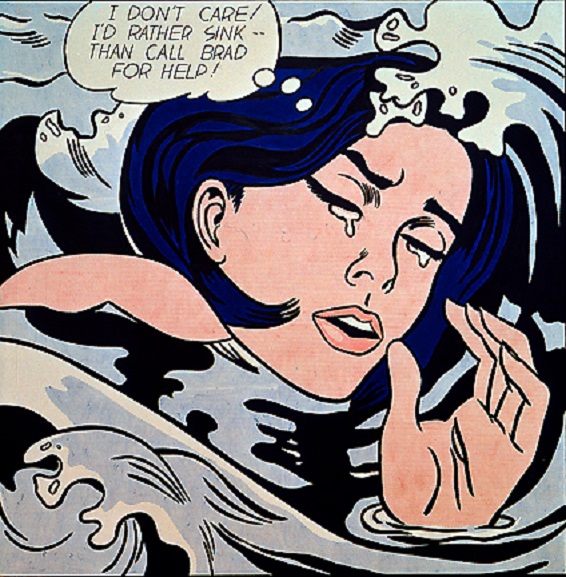
Pop Art equally Critical Realism
Pop Fine art came to fine art scene as a response to Abstruse Expressionism and its intellectual style devoid of contacts with the phenomenal reality. Pop artists such equally Jasper Johns, Robert Rauschenberg, Roy Lichtenstein, David Hockney, and Andy Warhol focused on the objects and themes from mass or popular civilisation and adult a critique of the marketplace system and intellectualism in art through their realistic depictions of mundane subjects.
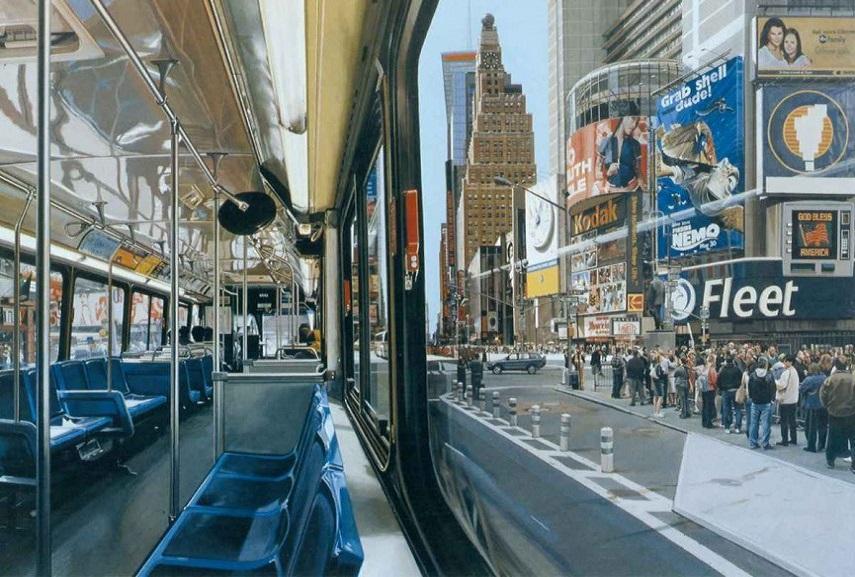
Contemporary Realisms – Photorealism/Hyperrealism
In modern and contemporary fine art Photorealism adult as an opposing creative fashion to Abstract Expressionism and Minimalist Fine art. Originating in the United states of america in the late 1960s and '70s Photorealism evolved from Popular Art and is marked past the use of photos as a basis and reference from which artists develop their works.[10] The process of creating photorealist art includes photographing of a desired object and its afterward transfer on sail. Criticizing the abundant presence of photography, artists of Photorealism aim to describe reality as truly every bit possible in painting, drawing or graphic media. Prominent American photorealists include Robert Bechtle, John Baeder, Richard Estes, Tom Blackwell, Ralph Goings, Chuck Shut, Charles Bell, Audrey Flack, and Don Eddy.
Hyperrealism , another form of creative realism is often considered a continuation of Photorealism. The difference between the two comes from the advances in technology that are at present allowing artists to create more detailed photos and to focus on infinitesimal details that were previously inaccessible. Along with attention to minuscule detail, hyperrealist works differ from photorealism in general expressive ability. While photorealists' works are generally cold and disinterested, washed in precise, mechanical style voided of whatsoever political or social engagement, realism of hyperrealists rely on depiction of motifs that seem to possess more light, vibrancy and texture than the referenced objects. In addition, the forms and objects are often combined in a way that cannot be seen in a real life, creating frequently imaginative reality enriched with layers of emotive, political and cultural content. Some of the painters that excel in this type of realism include Denis Peterson, Gottfried Helnwein, Robin Eley, Jessica Hess, Zaria Forman, and Elroy Morales.

Realisms in Context
As Linda Nochlin cautions, Realism never comes unencumbered with contextual meanings.[11] To understand one'southward time and reality ascertainment plays an integral part, merely idea that Realism art motion is just an authentic rendering of reality seems too narrow and flawed to suffer whatever serious examination. Whose reality Realism represents? Who holds the power to represent? And what one may choose to correspond are simply some of the questions that suggest the complexity of meaning word Realism holds. As shown from different creative and historical periods higher up, definition of Realism and Realism art move changed through ages frequently in correspondence to general social, political and cultural tendencies of a time. 1 chemical element that remained constant, though, was and is a need to show one's time as accurately every bit possible, which does not ever imply visual veracity.

Editor's Tip: Realism: (Style and Civilization)
In this volume, Linda Nochlin, i of the most prominent contemporary art historians, gives an overview of Realism and contextual and historical circumstances of its development. She uses examples both of European and American Realism in order to prove the prevalence of this art movement in the 19th and 20th century. She succinctly explains some misconceptions this term may produce, and makes a articulate distinction between reality and realism. The book is a proficient basis for anyone interested to know more about this of import historical style, and is illustrated with artworks of American, German language, French and Italian Realists.
References:
- Lombardi L.,(2008), From Realism to Fine art Nouveau, p.8.
- Ruckstuhl F. W., Idealism and Realism in Art, p.253.
- Anonimous, Plato'due south Aesthetics , Stanford Encyclopaedia of Philosophy [September 8, 2016]
- Bearding, Realism (Fine art) , Wikipedia [September ix, 2016]
- Friedlaender W., (1955), Caravaggio Studies, p.121.
- Lombardi Fifty., From Realism to Art Nouveau, p.9.
- Anonymous, Realism: History, Characteristics of Realist Fine art Motility and Naturalism , Visual Arts Cork [September 8, 2016]
- Juraga D., Booker K. Thou., (2002), Socialist Cultures East and Westward, p.68.
- Ruhrberg K. et al., (2005), Art of the 20th Century. Painting, Sculpture, New Media, Photography, p.186.
- Meisel L. K., Chase L., (2002), Photorealism at the Millennium, p.15.
- Nochlin L., (1992), Realism, p.10.
Featured images: Gustave Courbet - Le Sommeil, 1866. Image via wikipedia.org, Anibale Carracci - The Butcher's Shop, 1583. Image via wikipedia.org, Edward Hopper - Nighthawks, 1942. Prototype via wikipedia.org, John Jude Palencar - Pagan, 2014. Image via widewalls.ch, Robin Eley- The Nautilus Series-Hypostasis 2. Image via robineley.org. All images used for illustrative purposes only.
Source: https://www.widewalls.ch/magazine/definition-of-realism-art-movement
0 Response to "What Is Realism in Art and When Did Each Take Place"
Post a Comment